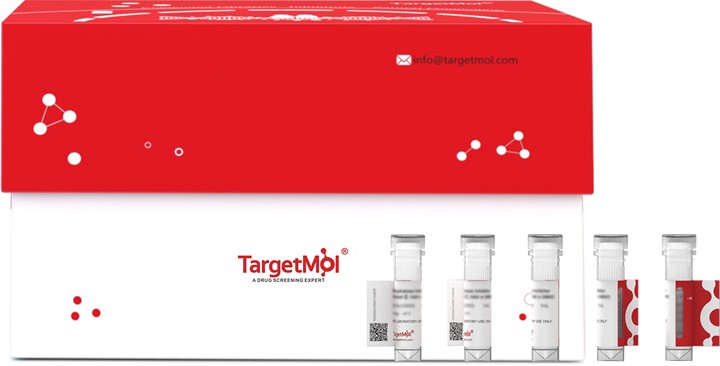 Your shopping cart is currently empty
Your shopping cart is currently empty
DR6 Protein, Mouse, Recombinant (hFc & His)
Catalog No. TMPJ-00358
Tumor necrosis factor receptor superfamily member 21(DR6) is a single-pass type I membrane protein and contains 1 death domain and 4 TNFR-Cys repeats. The protein may activate NF-kappa-B and promote apoptosis and it may activate JNK and be involved in T-cell differentiation.It is required for both normal cell body death and axonal pruning. Trophic-factor deprivation triggers the cleavage of surface APP by beta-secretase to release sAPP-beta which is further cleaved to release an N-terminal fragment of APP (N-APP). N-APP binds TNFRSF21 triggering caspase activation and degeneration of both neuronal cell bodies (via caspase-3) and axons (via caspase-6).

DR6 Protein, Mouse, Recombinant (hFc & His)
Catalog No. TMPJ-00358
Tumor necrosis factor receptor superfamily member 21(DR6) is a single-pass type I membrane protein and contains 1 death domain and 4 TNFR-Cys repeats. The protein may activate NF-kappa-B and promote apoptosis and it may activate JNK and be involved in T-cell differentiation.It is required for both normal cell body death and axonal pruning. Trophic-factor deprivation triggers the cleavage of surface APP by beta-secretase to release sAPP-beta which is further cleaved to release an N-terminal fragment of APP (N-APP). N-APP binds TNFRSF21 triggering caspase activation and degeneration of both neuronal cell bodies (via caspase-3) and axons (via caspase-6).
| Pack Size | Price | USA Warehouse | Global Warehouse | Quantity |
|---|---|---|---|---|
| 5 μg | $72 | 7-10 days | 7-10 days | |
| 10 μg | $116 | 7-10 days | 7-10 days | |
| 20 μg | $176 | 7-10 days | 7-10 days | |
| 50 μg | $310 | 7-10 days | 7-10 days | |
| 100 μg | $532 | 7-10 days | 7-10 days | |
| 200 μg | $919 | 7-10 days | 7-10 days | |
| 500 μg | $1,900 | 7-10 days | 7-10 days | |
| 1 mg | $2,730 | 7-10 days | 7-10 days |
Add to Cart
Add to Quotation
In Stock Estimated shipping dateUSA Warehouse [1-2 days] Global Warehouse [5-7 days]
All TargetMol products are for research purposes only and cannot be used for human consumption. We do not provide products or services to individuals. Please comply with the intended use and do not use TargetMol products for any other purpose.
Resource Download
Product Information
| Biological Activity | Activity has not been tested. It is theoretically active, but we cannot guarantee it. If you require protein activity, we recommend choosing the eukaryotic expression version first. |
| Description | Tumor necrosis factor receptor superfamily member 21(DR6) is a single-pass type I membrane protein and contains 1 death domain and 4 TNFR-Cys repeats. The protein may activate NF-kappa-B and promote apoptosis and it may activate JNK and be involved in T-cell differentiation.It is required for both normal cell body death and axonal pruning. Trophic-factor deprivation triggers the cleavage of surface APP by beta-secretase to release sAPP-beta which is further cleaved to release an N-terminal fragment of APP (N-APP). N-APP binds TNFRSF21 triggering caspase activation and degeneration of both neuronal cell bodies (via caspase-3) and axons (via caspase-6). |
| Species | Mouse |
| Expression System | HEK293 Cells |
| Tag | C-hFc-6xHis |
| Accession Number | Q9EPU5 |
| Synonyms | Tumor necrosis factor receptor superfamily member 21,Tnfrsf21,DR6,Death receptor 6,CD358,BM-018 |
| Amino Acid | Gln42-His349 |
| Construction | Gln42-His349 |
| Protein Purity | Greater than 95% as determined by reducing SDS-PAGE. (QC verified) |
| Molecular Weight | 75-120 KDa (reducing condition) |
| Endotoxin | < 0.1 ng/µg (1 EU/µg) as determined by LAL test. |
| Formulation | Lyophilized from a solution filtered through a 0.22 μm filter, containing PBS, pH 7.4. |
| Reconstitution | Reconstitute the lyophilized protein in distilled water. The product concentration should not be less than 100 μg/ml. Before opening, centrifuge the tube to collect powder at the bottom. After adding the reconstitution buffer, avoid vortexing or pipetting for mixing. |
| Stability & Storage | Lyophilized powders can be stably stored for over 12 months, while liquid products can be stored for 6-12 months at -80°C. For reconstituted protein solutions, the solution can be stored at -20°C to -80°C for at least 3 months. Please avoid multiple freeze-thaw cycles and store products in aliquots. |
| Shipping | In general, Lyophilized powders are shipping with blue ice. Solutions are shipping with dry ice. |
| Research Background | Tumor necrosis factor receptor superfamily member 21(DR6) is a single-pass type I membrane protein and contains 1 death domain and 4 TNFR-Cys repeats. The protein may activate NF-kappa-B and promote apoptosis and it may activate JNK and be involved in T-cell differentiation.It is required for both normal cell body death and axonal pruning. Trophic-factor deprivation triggers the cleavage of surface APP by beta-secretase to release sAPP-beta which is further cleaved to release an N-terminal fragment of APP (N-APP). N-APP binds TNFRSF21 triggering caspase activation and degeneration of both neuronal cell bodies (via caspase-3) and axons (via caspase-6). |
Dose Conversion
You can also refer to dose conversion for different animals. More
Calculator
Tech Support
Please read the User Guide of Recombinant Proteins for more specific information.
Generate Quote
Catalog No.: Cas No.:
Add
| Size | Quantity | Unit Price | Amount | Operation |
|---|
Generate Quote

Copyright © 2015-2025 TargetMol Chemicals Inc. All Rights Reserved.



